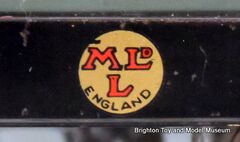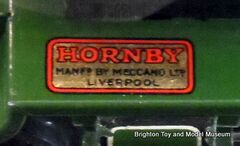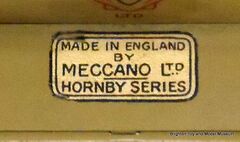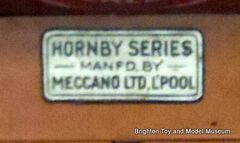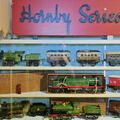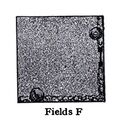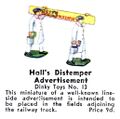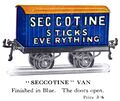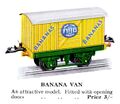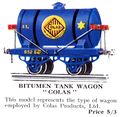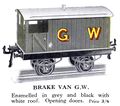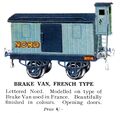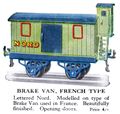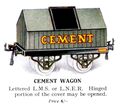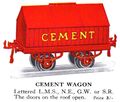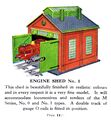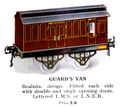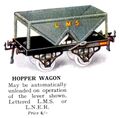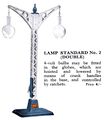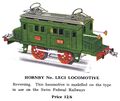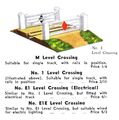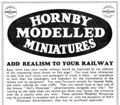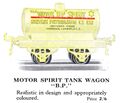Category:Hornby Series
Meccano/Hornby/Dinky :
Hornby Series | Dublo | Speedboats | Modelled Miniatures |
Serie Hornby | ACHO |
| Toy Brands and Manufacturers |
|---|
Hornby Series |
| 1920s - 1930s |
Early Hornby MLDL "Smiley" sticker [image info]
Simple "Hornby Series" sticker [image info]
A Hornby loco sticker [image info]
Hornby Series sticker without red border [image info]
Hornby Series sticker, pale gold [image info]
Hornby Series sticker [image info]
Hornby Series design, screenprinted version from the back of a Hornby No.2 Signal Cabin [image info]
1935: "Hornby Trains: A Perfect Miniature Railway" [image info]
1937: Hornby Series LMS "Princess Elizabeth" [image info]
1940: Hornby Trains advert [image info]
The Hornby Series marque appeared as the default branding on most gauge 0 model railway locomotives, rolling stock and accessories manufactured by Meccano Ltd. between World War One and World War Two. Oddly, while the items themselves tended to be marked "Hornby Series", their associated advertising tended to use "Hornby Trains" instead.
Frank Hornby's company Meccano Ltd started making model railways shortly after the end of the First World War, with the "Hornby Series" markings appearing after a few other short-lived Hornby- and Meccano-related experiments with branding. It's difficult to tell exactly when the distinctive "Hornby Series" label design was dropped, but it seems to have started being phased out after Frank Hornby's death in 1936, suggesting that perhaps the founder may have considered it to be his own personal mark.
The marque didn't appear on the smaller 00-gauge Hornby Dublo products (1938-) or on the company's simplified range of post-war gauge 0 products.
For convenience, these museum pages use "Hornby Series" category to refer to any gauge 0 Meccano Ltd. model railway equipment produced before the Second World War, regardless of markings.
Birth: The Hornby Clockwork Train
The Hornby Clockwork Train appeared in 1920 as a richly stove-enamelled black loco and train, accompanied by its cheaper and more conventional litho-printed sibling, The Hornby Tin Printed Train. The more expensive-looking enamelled version was wildly popular, arriving at a time when the German brands who had previously dominated the market now found it difficult or impossible to sell to British consumers. Added to the difficulty that many customers simply didn't want to buy German, was the retailers' concerns that at any moment new duties might be put on imported German goods. The British train-buying market needed a new home-produced brand that was preferably cheaper than the very nice-but-expensive Bassett-Lowke products, and Frank Hornby was the man to give it to them, helped by Meccano Ltd.'s network of dealers and promotions in the Meccano Magazine, some of whose whose loyal readers were liable to buy the new trains, sight unseen, simply on Frank Hornby's recommendation.
Constructional element
The Hornby Clockwork Train was deliberately assembled with standard Meccano nuts and bolts, to emphasise that it was a Meccano product. The nuts-and-bolts approach was quickly dropped in favour of a more conventional "tabbed" construction, but the Meccano method also appeared on some early Hornby accessories, namely the famous "lattice bridge", and some of the early wagons.
Zulu Trains
Hornby's new enamelled train set had been released alongside a more traditional (and slightly cheaper) litho-printed set, The Hornby Tin Printed Train. However, the shiny enamelled version was much more popular, so Meccano Ltd produced a new range, Zulu Trains, which had the same high-gloss finish of the Hornby-branded trains but with a more conventional (and less expensive) tabbed and riveted construction.
Hornby Trains / Hornby Series
Since it was becoming clear that Meccano-style nuts and bolts construction idea wasn't that important to customers, and phasing it out meant losing one of the main distinguishing features between the Hornby and Zulu brands, Meccano Ltd decided to merge the contents of both ranges into a single range, Hornby Trains.
Confusingly, although the Hornby Trains name appeared in the company's printed material, the "Hornby Trains" marque didn't seem to appear anywhere on the actual products, which initially used an an "MLDL" sticker or embossed stamp for "Meccano Ltd, Liverpool" and later bore stickers or logos proudly announcing them to be "Hornby Series" trains, (again, made by Meccano). Over in France, the French Hornby gauge 0 products were typically stickered "Hornby" or "Serie Hornby". To make matters even more confusing, the gold or red-and-gold "Hornby Series" stickers also occasionally appeared on other isolated items that weren't at all train-related, such as the Meccano sawbench.
Tiering
The merging of the Hornby and Zulu brands meant that Meccano Ltd now had versions of tender and tank locos at different price points, and decided to implement a tiered pricing system reminiscent of the numbered Meccano sets, whereby the default version of an item was the No.1, the more expensive "aspirational version was the No.2, and a cut-down version would be the No.0
The No.1 locos were standard four-wheeled "0-4-0" engines based on the original Hornby Clockwork Train, the No.2 locos were bigger with more wheels, and more numbers were added to the system as the the sophistication (and cost) increased, along with enhanced "special" variants. As the No.1 and No.0 locos continued to be developed and improved, it sometimes became quite difficult to tell them apart.
The numbering also applied to accessories - the No.1 Signal Cabin had solid tin windows and a printed staircase, but the No.2 had punched-through "open" windows, physical stairs on one side, and a hinged back to allow it to be fitted with the Hornby Control System.
M Series
A further separate range of entry-level pieces and sets aimed at younger children was introduced as the M Series. The M Series locos were the descendants of the Tin Printed Train, were litho-printed rather than enamelled, and the locos and their coaches had different couplings to the "standard" range. The M Series then ended up spawning even more variations (like separate M0 and M1 locos), in an attempt to make sure that the Hornby range had products to meet as many potential buyers' budgets as possible.
Product proliferation
The Hornby Series model railway system continued to expand through the late 1920s and early 1930, and Hornby's customers continued to add new accessories to their expanding layouts. You could buy Hornby railway stations and signals, wire mechanical remote controls, trees, prefabricated scenery sections, and even painted lead passengers, luggage, and farmyard animals to populate any fields alongside your Hornby track. Meccano Ltd benefited from being late entrants to the model railway market, in that they only supported a single gauge and scale - gauge 0 - whereas more established model railway companies like Märklin, Bing and Bassett-Lowke also had to contend with gauge 1, gauge 2, and perhaps even larger legacy gauges. As a result, where a German company might have to produce a single accessory item in three different sizes, Meccano Ltd could put the same design energy and production space into instead producing three different products in a single size - and their customers would then have more choice, and the option of buying all three.
Hornby's first electric train set appeared in 1925, a potentially lethal 110-Volt version of the Metropolitan Railway's new electric underground train], and once the bugs had been sorted out, electric versions of other Hornby locos started to appear. As Hornby's larger locomotives became more sophisticated and began to evolve into more realistic models (as opposed to generic toys) they started to become increasingly modelled after real locomotives, with the breakthrough coming in 1929 when the company launched the No.2 Special range, where locos didn't just have different paintwork to signify different railway companies, they also had appreciably different superstructure.
The high point of Hornby's Gauge 0 output was arguably the 1937 No.4 "Eton" locomotive and the glorious 4-6-2 "Princess Elizabeth" locomotive (also 1937), Hornby's largest loco, and the first (and only) six-wheel-drive locomotive that the company ever produced in gauge 0.
Post-war
With the new smaller Hornby Dublo system appearing in 1938, the company's focus switched to the new smaller format, and development then ceased almost completely during the War years. It took Meccano Ltd a little while to get back into the full swing of production after World War Two, and by this time, Dublo badly needed most of the company's attention, as the second wave of Dublo products announced in 1939 had been interrupted by the war. Initial production of gauge 0 after the war appeared to be indistinguishable from pre-war production, to the extent that it may well have been old stock, or built partly from pre-war components to the pre-war plans.
In the 1950s Meccano Ltd. overhauled the gauge 0 range (having by now presumably having used up most of the old stock and components). They stopped making most of the "fancy" pieces, simplified some of the remaining accessories, and reverted to only making the simpler "0-4-0" locos. This revamped, simpler range removed the pre-war numbering system with its various tiered numbers and "M" variants, and shrank to four basic levels of train set, numbered 20, 30, 40 and 50 for the goods sets, and 21, 31, 41 and 51 for the corresponding passenger sets, all now only available in clockwork.
The gauge 0 trains, now essentially a "legacy" range with no real further development, eventually petered out in the 1960s.
Subcategories
This category has the following 24 subcategories, out of 24 total.
F
- French Hornby (6 P, 37 F)
H
- Hornby Complete (1 P, 18 F)
- Hornby Countryside (13 P, 29 F)
- Hornby MLDL (4 P, 1 F)
- Hornby No 0 locomotives (4 P, 4 F)
- Hornby No1 locomotives (5 P, 11 F)
- Hornby No1 Special locomotives (3 P, 7 F)
- Hornby No1 Special Tank locomotives (3 P, 7 F)
- Hornby No1 Tank locomotives (7 P, 14 F)
- Hornby No2 locomotives (3 P, 8 F)
- Hornby No2 Special locomotives (7 P, 16 F)
- Hornby No2 Special Pullman Coaches (10 P, 8 F)
- Hornby No2 Special Tank locomotives (5 P, 8 F)
- Hornby No2 Tank locomotives (6 P, 9 F)
- Hornby No4 locomotives (2 P, 5 F)
- Hornby Series (display) (37 P, 21 F)
- Hornby Trains post-war (6 P, 2 F)
M
Pages in category ‘Hornby Series’
The following 200 pages are in this category, out of 255 total.
(previous page) (next page)B
- Bitumen Tank Wagon, Colas (Hornby 0 gauge)
- Bitumen Tank Wagon, Colas (Hornby Series)
- Blue Pullman carriage (Hornby Series)
- Brake Van GW, pb (Hornby Series)
- Brake Van, GNR (Hornby Series)
- Bramham Moor locomotive 201 (Hornby Series E220)
- Breakdown Crane and Van, brown, (Hornby Series)
- Breakdown Crane Wagon (Hornby M0)
- Breakdown Van and Crane, grey, LMS (Hornby Series)
C
- Cadbury's Chocolate Van (Hornby 1930s)
- Cadbury's Van, pb (Hornby Series)
- Carr's Biscuit Van, 1920s (Hornby Series)
- Carr's Biscuit Van, 1930s (Hornby Series)
- Coal Wagon, 'Hornby Railway Company' (Hornby Series)
- Coal Wagon, 'Meccano' (Hornby Series)
- Colman's Mustard Van (Hornby 1924)
- Countryside Section F (Hornby Series)
- Countryside Section G1 (Hornby Series)
- Countryside Section G2 (Hornby Series)
- Countryside Section H, roadway (Hornby Series)
- Countryside Section K2 (Hornby Series)
- Countryside Section L1 (Hornby Series)
- Countryside Section M1 (Hornby Series)
- County of Bedford locomotive 3821 (Hornby Series E220)
- Cows (Dinky Toys 2b)
- Crane Truck, early (Hornby Series)
- Crawford's Biscuit Van type 3, pb (Hornby Series)
- Crawford's Biscuit Van, 1920s (Hornby Series)
- Crawford's Biscuit Van, 1920s, variation (Hornby Series)
- Crawford's Biscuit Van, 1930s (Hornby Series)
- Crawford's Biscuit Van, 1930s, variation (Hornby Series)
- Cutting No0 (Hornby Series)
E
F
- Farmyard Animals (Dinky Toys 2)
- Flying Scotsman No3 locomotive 4472 (Hornby Series)
- Flèche d'Or (Golden Arrow) train set (Hornby France)
- Folkestone Flyer No2 Special LMS train set (Hornby Series)
- Foot Bridge with signals (Hornby Series)
- Footbridge, M Series (Hornby Series)
- Furniture Container, LMS K61 (Hornby Series)
- Fyffes Banana Van (Hornby gauge 0)
- Fyffes Banana Van, pb (Hornby Series)
G
- Gas Cylinder Wagon (Hornby Series)
- Gas Cylinder Wagon, green, SR (Hornby)
- Gas Cylinder Wagon, LMS-GC (Hornby Series)
- George the Fifth locomotive 2663 (Meccano Ltd / Hornby No.00 / Hornby M3)
- Goods Container, LNER BLS 297 (Hornby Series)
- Goods Platform, 1926 (Hornby Series)
- Goods Platform, 1929 (Hornby Series)
- Goods Wagon (Hornby M0)
- Goods Wagon, GW, pb (Hornby Series)
- GPV Gunpowder Van, GW, grey (Hornby Series)
- Great Western 5500 locomotive, 6V (Hornby EPM16)
- Gunpowder Van, LMS (Hornby Series)
- Gunpowder Van, LNWR (Hornby MLDL)
H
- Hall's Distemper 'workmen' sign (Dinky Toys 13)
- Hall's Distemper Advertisement (Hornby Modelled Miniatures)
- Hopper Wagon, grey, LNER (Hornby Series)
- Hopper Wagon, pb (Hornby Series)
- Hopper Wagon, red, SR (Hornby Series)
- Hopper Wagon, red, SR, 1930s (Hornby Series)
- Hornby 501 loco, BR 50153 (Hornby Trains)
- Hornby Complete Railway Set M10
- Hornby Controller (display)
- Hornby No0 Goods Train Set, LNER 5096 (Hornby Series)
- Hornby Railway Station No.4E, 1 (Hornby Series)
- Hornby Railway Station No.4E, 2 (Hornby Series)
- Horses (Dinky Toys 2a)
- Hydraulic Buffer Stops, blue, No2E (Hornby Series)
- Hydraulic Buffer Stops, green and gold, No2 (Hornby Series)
- Hydraulic Buffer Stops, No3E (Hornby Series)
J
L
- Lamp Standard No1E Electrical (Hornby Series)
- Lamp Standard No2E Electrical (Hornby Series)
- Lamp standard, single globe (Hornby Series)
- Lattice Girder Bridge, 1921 (Hornby Series)
- Level Crossing (Hornby Series)
- LMS locomotive 6161 (Hornby Series)
- LNWR locomotive 3435 (Hornby Series)
- LNWR wagon, type 1 (Hornby MLDL)
- Loading Gauge, ~1925 (Hornby Series)
- Loading Gauge, ~1926 (Hornby Series)
- Loading Gauge, ~1934 (Hornby Series)
- Loco Southern 29, No1 Electric Tank Loco (Hornby Series)
- Loco Southern 29, No1 Tank Loco (Hornby Series)
- Locomotive GW 2221, No2 Special Tank (Hornby Series)
- Locomotive GW 2711, No2 (Hornby Series)
- Locomotive LMS 0-4-0, No1 Tank Loco (Hornby Series)
- Locomotive LMS 1185 (Hornby Series E220)
- Locomotive LMS 2051, Tank Loco No2 (Hornby Series)
- Locomotive LMS 8712, No1 Special (Hornby Series)
- Locomotive LNER 0-4-0, No1 Tank Loco (Hornby Series)
- Locomotive LNER 2162, No1 Special (Hornby Series)
- Locomotive LNER 2900, Tank Loco No1 (Hornby Series)
- Locomotive LNER 460, Tank Loco No2 (Hornby Series)
- Locomotive No2 Special, LMS 1185 (Hornby Series)
- Locomotive Southern 1759, No.2 Special (Hornby Series)
- Locomotive Southern B 602,Tank Loco No2 (Hornby Series)
- Locomotive Southern B 604,Tank Loco No2 (Hornby Series)
- Lord Nelson loco 850, No3 (Hornby Series)
- Luggage Van No.1, brown, SR (Hornby Series)
- Luggage Van No.2, GW (Hornby Series)
- Lumber Wagon No.1, L&NER (Hornby Series)
- Lumber Wagon No.2, LMS (Hornby Series)
M
- M Series Station Set
- M0 Locomotive 6161 (Hornby Series)
- M1 Locomotive 3435 (Hornby Series)
- McAlpine Side-Tipping Wagon, pb (Hornby Series)
- Metropolitan Train, HV (Hornby Series)
- Metropolitan underground locomotive, 110V (Hornby)
- Metropolitan underground locomotive, 6V (Hornby)
- Milk Cans with Truck (Hornby Series)
- Milk Tank Wagon, Nestlé's Milk (Hornby Series)
- Milk Tank Wagon, United Dairies (Hornby Series)
- Milk Tank Wagon, United Dairies, early (Hornby Series)
- Milk Traffic Van (Hornby gauge 0)
- Miniature Luggage and Truck (Hornby Railway Accessories No. 1)
- Montana Pullman car (Hornby Series)
N
- No 0 locomotive 2710 (Hornby Series)
- No 0 Locomotive 4797 (Hornby Series)
- No. 1 Luggage Van (Hornby gauge 0)
- No. 1 Special Tank Locomotive 70 (Hornby Series)
- No1 Special Electric Tank Locomotive, Southern 516 (Hornby Series E120 )
- No1 Special Locomotive, electric, Southern 1179 (Hornby Series E120)
- No2 Tank Loco LMS 2052 (Hornby Series)
- No21 Passenger Train Set, loco 60985 (Hornby Trains)
- No3 Passenger Train Set, box only (Hornby Series)
P
- Palethorpe's Sausage Van (Hornby 1938)
- Passenger Train Set LMS 5600 (Hornby No 501)
- Passenger Train Set SR E 126 Tank Loco (Hornby Trains)
- Passenger Train Set, LMS 5600 (Hornby Trains)
- Passengers (Dinky Toys 3)
- Petrol Tank Wagon, BP (Hornby M0)
- Petrol Tank Wagon, BP Motor Spirit
- Petrol Tank Wagon, National Benzole (Hornby Series)
- Petrol Tank Wagon, Power Ethyl (Hornby Series)
- Petrol Tank Wagon, Pratts (Hornby Series)
- Petrol Tank Wagon, Pratts, round logo (Hornby Series)
- Petrol Tank Wagon, Redline-Glico (Hornby Series)
- Petrol Tank Wagon, Shell Motor Spirit (Hornby Series)
- Petrol Tank Wagon, Shell-Mex BP (Hornby Series)
- Pigs (Dinky Toys 2c)
- Platelayer's Hut (Hornby Series)
- Police Motorcycle Patrol (Dinky Toys 42b)
- Princess Elizabeth locomotive 6201 (Hornby Series)
- Princess Elizabeth locomotive 6201, in presentation case (Hornby Series)
- Pullman carriages (Hornby Series)
- Pullman coach, Aurelia (Hornby M1 gauge 0)
- Pullman coach, Marjorie (Hornby M1 gauge 0)
- Pullman Dining Car, green (Hornby Series)
- Pullman GW train set, No2 (Hornby Series)
- Pullman No2 coaches (Hornby Series)
- Pullman No2 Special Coach (Composite), Alberta (Hornby Series)
- Pullman No2 Special Coach (Composite), Arcadia (Hornby Series)
- Pullman No2 Special Coach (Composite), Arcadia, A37 (Hornby Series)
- Pullman No2 Special Coach (Composite), Verona (Hornby Series)
- Pullman No2 Special Coach, Grosvenor (Hornby Series)
- Pullman No2 Special Coach, Iolanthe (Hornby Series)
- Pullman No2 Special Coach, Iolanthe, A37 (Hornby Series)
- Pullman No2 Special Coach, Loraine (Hornby Series)
- Pullman No2 Special Coach, Zenobia (Hornby Series)
- Pullman Passenger Train Set, Loco 3435 (Hornby Trains
R
S
- Seccotine Van (Hornby 0 gauge)
- Seccotine Wagon (Hornby Series)
- Seccotine Wagon, pb (Hornby Series)
- Shepherd Set (Dinky Toys 6)
- Shepherd Set, loose (Dinky Toys 6)
- Side Tipping Wagon (Hornby M0)
- Signal Cabin No2 (Hornby Series)
- Signal Cabin No2E (Hornby Series)
- Signal cabin with transformer (Hornby gauge 0)
- Signal Cabin, No1 (Hornby Series)
- Signal No2, Distant, flat top (Hornby Series)
- Signal No2, dual arm, Home and Distant, flat top (Hornby Series)
- Signal No2, Single Arm, Distant, postwar (Hornby Trains)
- Signal No2E, distant, blue (Hornby Series)
- Signal No2E, green (Hornby Series)
Media in category ‘Hornby Series’
The following 200 files are in this category, out of 443 total.
(previous page) (next page)- Arcadia, Hornby No1 Special Pullman Coach (TRM 1929-03).jpg 2,860 × 1,850; 2.24 MB
- Area 33.jpg 800 × 799; 404 KB
- Beware of the Trains.jpg 1,024 × 577; 382 KB
- Chinese Lantern, Meccano Ltd - Hornby Trains, detail.jpg 2,800 × 1,867; 2.5 MB
- Colouring-in sheet - Hornby Series Wagon.jpg 3,508 × 2,482; 803 KB
- Colouring-in sheet - M-Series Locomotive.jpg 3,508 × 2,482; 830 KB
- Colouring-in sheet - Pullman Carriage.jpg 3,508 × 2,482; 1.32 MB
- Colouring-in sheet - Seccotine Wagon.jpg 3,508 × 2,482; 940 KB
- Containers for Hornby Trains (MM 1936-09).jpg 1,600 × 1,302; 630 KB
- Countryside Sections (HBoT 1932).jpg 1,092 × 812; 203 KB
- Countryside Sections closeup01 (MM 1933-06).jpg 3,097 × 1,765; 907 KB
- Countryside Sections closeup02 (MM 1933-06).jpg 2,756 × 2,061; 989 KB
- Countryside Sections closeup03 (MM 1933-06).jpg 2,768 × 1,953; 970 KB
- Countryside Sections, assembled (HBoT 1932).jpg 4,289 × 1,521; 926 KB
- Engineering Staff, Dinky Toys No 4 (1935 BHTMP).jpg 889 × 427; 57 KB
- Eton 900 locomotive detail, Hornby.jpg 800 × 600; 381 KB
- Eton locomotive 900 (MM 1937-08).jpg 1,583 × 729; 286 KB
- Eton locomotive 900 article (MM 1937-08).jpg 2,438 × 3,458; 1.4 MB
- Fields F, Hornby Countryside Sections (HBoT 1934).jpg 807 × 811; 124 KB
- Fields G1, Hornby Countryside Sections (HBoT 1934).jpg 712 × 415; 46 KB
- Fields G2, Hornby Countryside Sections (HBoT 1934).jpg 712 × 415; 47 KB
- Fields J1, Hornby Countryside Sections (HBoT 1934).jpg 1,078 × 628; 120 KB
- Fields J2, Hornby Countryside Sections (HBoT 1934).jpg 1,078 × 628; 118 KB
- Fields J3, Hornby Countryside Sections (HBoT 1934).jpg 1,078 × 460; 67 KB
- Fields K1, Hornby Countryside Sections (HBoT 1934).jpg 807 × 811; 74 KB
- Fields K2, Hornby Countryside Sections (HBoT 1934).jpg 807 × 811; 76 KB
- Fields L1, Hornby Countryside Sections (HBoT 1934).jpg 712 × 415; 47 KB
- Fields L2, Hornby Countryside Sections (HBoT 1934).jpg 712 × 415; 49 KB
- Fields M1, Hornby Countryside Sections (HBoT 1934).jpg 613 × 693; 54 KB
- Fields M2, Hornby Countryside Sections (HBoT 1934).jpg 613 × 693; 54 KB
- Folkestone Flyer No2 Special train Set, SR (HBoT 1938).jpg 2,599 × 1,641; 456 KB
- French Hornby, gauge 0, selection.jpg 2,133 × 1,600; 505 KB
- Furniture Container, LMS K61, Hornby Series (MM 1936-09).jpg 734 × 655; 130 KB
- Gamleys-branded Meccano Ltd catalogue, cover (1927).jpg 2,022 × 3,000; 3.76 MB
- Gas cylinder wagon, SR, green (Hornby).jpg 800 × 600; 239 KB
- George the Fifth loco 2663 (Meccano Ltd).jpg 1,024 × 639; 80 KB
- Goods Container, LNER BLS 297, Hornby Series (MM 1936-09).jpg 757 × 696; 134 KB
- Halls Distemper Advertisement, Dinky Toys No 13 (1935 BHTMP).jpg 515 × 511; 39 KB
- HBOT 1938-39 p15 Princess Elizabeth model.jpg 1,638 × 1,235; 575 KB
- Hornby 'Golden Arrow' No3 train set (HBoT 1938).jpg 3,041 × 1,641; 592 KB
- Hornby 'Seccotine' Van (1928 HBoT).jpg 715 × 603; 72 KB
- Hornby 3C GWR Cornish Riviera box end (~1927).jpg 720 × 356; 128 KB
- Hornby and Zulu Trains (MM 1924-03).jpg 1,605 × 2,114; 453 KB
- Hornby Banana Van, Fyffes (HBoT 1931).jpg 1,201 × 1,045; 156 KB
- Hornby Barrel Wagon (HBoT 1931).jpg 1,193 × 889; 118 KB
- Hornby Bitumen Tank Wagon, Colas (HBoT 1930).jpg 693 × 675; 83 KB
- Hornby Box Car, American Type (HBoT 1930).jpg 856 × 581; 94 KB
- Hornby Brake Van GW (1926 HBoT).jpg 1,453 × 1,243; 199 KB
- Hornby Brake Van GW (1928 HBoT).jpg 729 × 645; 71 KB
- Hornby Brake Van LMS (1925 HBoT).jpg 762 × 614; 64 KB
- Hornby Brake Van LMS (1928 HBoT).jpg 735 × 597; 67 KB
- Hornby Brake Van LNER (1925 HBoT).jpg 737 × 682; 70 KB
- Hornby Brake Van LNER (1928 HBoT).jpg 731 × 673; 70 KB
- Hornby Brake Van SR (1928 HBoT).jpg 725 × 649; 69 KB
- Hornby Brake Van, French Type (1927 HBoT).jpg 741 × 697; 97 KB
- Hornby Brake Van, French Type (1928 HBoT).jpg 745 × 707; 93 KB
- Hornby Breakdown Van and Crane (1927 HBoT).jpg 1,019 × 741; 118 KB
- Hornby Breakdown Van and Crane (1928 HBoT).jpg 1,033 × 703; 112 KB
- Hornby Breakdown Van and Crane LMS-LNER (1925 HBoT).jpg 1,003 × 705; 102 KB
- Hornby Buffer Stops No1 (spring) (HBoT 1930).jpg 749 × 623; 76 KB
- Hornby Buffer Stops No2 (hydraulic) (HBoT 1930).jpg 1,691 × 1,133; 206 KB
- Hornby Caboose, American Type (HBoT 1930).jpg 863 × 609; 98 KB
- Hornby Carr's Biscuit Van (1925 HBoT).jpg 721 × 651; 64 KB
- Hornby Carr's Biscuit Van (HBoT 1930).jpg 739 × 593; 78 KB
- Hornby Cement Wagon (1925 HBoT).jpg 729 × 648; 64 KB
- Hornby Cement Wagon (1928 HBoT).jpg 717 × 609; 64 KB
- Hornby Clockwork Train, detail.jpg 1,024 × 768; 500 KB
- Hornby Clockwork Trains BAG logo 1925.jpg 2,690 × 602; 154 KB
- Hornby Coal Wagon (HBoT 1931).jpg 1,162 × 876; 119 KB
- Hornby combined loco tool (HBoT 1930).jpg 2,457 × 605; 152 KB
- Hornby Complete advertising M8 and M9 (1939 HBot).jpg 1,095 × 828; 189 KB
- Hornby Complete M10 and M11 (1939 HBot).jpg 3,282 × 2,478; 1.16 MB
- Hornby Complete M10 box (1939 HBot).jpg 1,913 × 2,066; 500 KB
- Hornby Complete M10 layout (1939 HBot).jpg 3,493 × 1,625; 512 KB
- Hornby Complete M11 box (1939 HBot).jpg 1,775 × 2,018; 451 KB
- Hornby Complete M11 layout (1939 HBot).jpg 3,797 × 1,477; 495 KB
- Hornby Complete M8 box (1939 HBot).jpg 1,891 × 1,875; 501 KB
- Hornby Complete M8 layout (1939 HBot).jpg 2,273 × 1,399; 347 KB
- Hornby Complete M9 box (1939 HBot).jpg 1,905 × 2,052; 576 KB
- Hornby Complete M9 layout (1939 HBot).jpg 2,449 × 1,541; 415 KB
- Hornby Complete.jpg 1,204 × 671; 103 KB
- Hornby Control System (1927 HBoT).jpg 3,215 × 2,408; 1.07 MB
- Hornby Countryside Sections (MM 1936-09).jpg 2,366 × 2,937; 1.07 MB
- Hornby Countryside Sections, layout (HBoT 1934).jpg 4,461 × 1,590; 932 KB
- Hornby Countryside Sections, oval (HTPYHR).jpg 1,807 × 1,465; 215 KB
- Hornby Countryside Sections, page (HBoT 1934).jpg 2,163 × 1,605; 657 KB
- Hornby Countryside Sections,Figure 8 (HTPYHR).jpg 1,110 × 2,345; 268 KB
- Hornby Covered Wagon, French Type (HBoT 1930).jpg 741 × 787; 102 KB
- Hornby Crane Truck (1925 HBoT).jpg 761 × 735; 64 KB
- Hornby Crane Truck (1928 HBoT).jpg 749 × 726; 69 KB
- Hornby Crane Truck (HBoT 1931).jpg 1,213 × 1,093; 137 KB
- Hornby Crawford's Biscuit Van (1925 HBoT).jpg 734 × 639; 65 KB
- Hornby Crawford's Biscuit Van (1928 HBoT).jpg 734 × 643; 72 KB
- Hornby Double Arm Signal No.2 (1928 HBoT).jpg 521 × 1,233; 60 KB
- Hornby Double Arm Signal No1 (1935 BHTMP).jpg 385 × 1,024; 38 KB
- Hornby Double Arm Signal No2 (1935 BHTMP).jpg 476 × 1,182; 62 KB
- Hornby Double Lamp Standard (1925 HBoT).jpg 565 × 1,266; 67 KB
- Hornby Double Lamp Standards (MM 1924-02).jpg 680 × 1,192; 61 KB
- Hornby Double Wine Wagon (detail).jpg 1,024 × 768; 350 KB
- Hornby Double Wine Wagon (HBoT 1930).jpg 861 × 662; 90 KB
- Hornby E120 Special Passenger Train (1939- catalogue).jpg 2,371 × 753; 502 KB
- Hornby E220 Electric Tank Goods Train (1939- catalogue).jpg 2,365 × 713; 387 KB
- Hornby E220 Special Locomotive, LMS 1185 (HBoT 1934).jpg 1,961 × 1,477; 402 KB
- Hornby E36 Metropolitan Locomotive (HBoT 1934).jpg 2,127 × 1,225; 375 KB
- Hornby E420 Eton Locomotive (1939- catalogue).jpg 2,269 × 999; 278 KB
- Hornby Electric Lighting System (MM 1936-06).jpg 2,284 × 1,479; 621 KB
- Hornby Engine Shed No.1 (1928 HBoT).jpg 864 × 933; 125 KB
- Hornby Engine Shed No.2 (1928 HBoT).jpg 961 × 880; 137 KB
- Hornby Fencing, with four trees (1935 BHTMP).jpg 910 × 640; 77 KB
- Hornby Fibre Wagon (HBoT 1931).jpg 1,141 × 893; 127 KB
- Hornby Fish Van (HBoT 1931).jpg 1,389 × 1,037; 188 KB
- Hornby Foot Bridge No.2 (1928 HBoT).jpg 1,261 × 819; 89 KB
- Hornby Foot Bridges (HBoT 1930).jpg 1,251 × 827; 101 KB
- Hornby Footbridge No.1 and No.2 (1925 HBoT).jpg 743 × 728; 54 KB
- Hornby Footbridge No1A (1935 BHTMP).jpg 1,221 × 677; 93 KB
- Hornby Gas Cylinder Wagon (1925 HBoT).jpg 747 × 536; 44 KB
- Hornby Gas Cylinder Wagon (1926 HBoT).jpg 725 × 565; 56 KB
- Hornby Gas Cylinder Wagon (1928 HBoT).jpg 722 × 606; 57 KB
- Hornby George V Clockwork Trains (MC 1925).jpg 1,695 × 1,031; 169 KB
- Hornby Goods Platform (1926 HBoT).jpg 1,731 × 1,007; 239 KB
- Hornby Goods Platform (HBoT 1930).jpg 1,526 × 896; 189 KB
- Hornby Guard's Van (1926 HBoT).jpg 1,505 × 1,369; 250 KB
- Hornby Guard's Van (1928 HBoT).jpg 759 × 687; 85 KB
- Hornby Guard's Van, LMS LNER (1925 HBoT).jpg 781 × 697; 71 KB
- Hornby Gunpowder Van (1928 HBoT).jpg 749 × 701; 71 KB
- Hornby Gunpowder Van LMS LNER (1925 HBoT).jpg 768 × 692; 68 KB
- Hornby GW Gunpowder Van (1926 HBoT).jpg 707 × 609; 57 KB
- Hornby Hedging (1935 BHTMP).jpg 1,174 × 289; 69 KB
- Hornby Hopper Wagon (1928 HBoT).jpg 717 × 643; 73 KB
- Hornby Hopper Wagon, LMS LNER (1925 HBoT).jpg 717 × 706; 66 KB
- Hornby Hydraulic Buffer Stop (1925 HBoT).jpg 741 × 590; 57 KB
- Hornby Island Platform (1926 HBoT).jpg 2,802 × 1,191; 376 KB
- Hornby Island Platform, Windsor (HBoT 1930).jpg 2,625 × 938; 216 KB
- Hornby Jacob's Biscuit Van (1925 HBoT).jpg 733 × 629; 59 KB
- Hornby Jacob's Biscuit Van (1928 HBoT).jpg 749 × 610; 68 KB
- Hornby Junction Signal (1925 HBoT).jpg 481 × 1,280; 66 KB
- Hornby Junction Signal (1928 HBoT).jpg 601 × 1,265; 65 KB
- Hornby Junction Signal No1 (1935 BHTMP).jpg 434 × 1,033; 41 KB
- Hornby Junction Signal No2 (1935 BHTMP).jpg 446 × 1,083; 54 KB
- Hornby Lamp Standard No 2E (1935 BHTMP).jpg 449 × 1,129; 55 KB
- Hornby Lamp Standard No.2 (Double) (1928 HBoT).jpg 839 × 947; 70 KB
- Hornby Lamp Standard No1 (1935 BHTMP).jpg 613 × 1,216; 69 KB
- Hornby Lamp Standard No1 (single) (HBoT 1930).jpg 500 × 1,365; 216 KB
- Hornby Lamp Standard No2 (double) (HBoT 1930).jpg 561 × 1,269; 78 KB
- Hornby Lattice Girder Bridge (1925 HBoT).jpg 759 × 614; 60 KB
- Hornby Lattice Girder Bridge (1928 HBoT).jpg 1,255 × 691; 117 KB
- Hornby LE120 Locomotive, Swiss (HBoT 1934).jpg 1,945 × 1,301; 298 KB
- Hornby LEC1 Locomotive, Swiss (HBoT 1934).jpg 2,063 × 1,735; 366 KB
- Hornby Level Crossing (1925 HBoT).jpg 822 × 743; 72 KB
- Hornby Level Crossing No.1 (1928 HBoT).jpg 689 × 476; 49 KB
- Hornby Level Crossing No.2 (1928 HBoT).jpg 781 × 723; 76 KB
- Hornby Level Crossing No1 (1935 BHTMP).jpg 809 × 813; 92 KB
- Hornby Level Crossing No2 (1935 BHTMP).jpg 809 × 828; 107 KB
- Hornby Loading Gauge (1925 HBoT).jpg 701 × 921; 36 KB
- Hornby Loading Gauge (1927-28 HBoT).jpg 781 × 923; 50 KB
- Hornby loco sticker.jpg 400 × 243; 68 KB
- Hornby M Series Footbridge (1935 BHTMP).jpg 773 × 621; 75 KB
- Hornby M Series Signal (1935 BHTMP).jpg 543 × 906; 28 KB
- Hornby M Series Signal Box (1935 BHTMP).jpg 565 × 712; 89 KB
- Hornby M Series Station (1935 BHTMP).jpg 1,187 × 601; 107 KB
- Hornby M Series Station Set (1935 BHTMP).jpg 2,853 × 1,025; 337 KB
- Hornby M Series Telegraph Pole No.1 (1935 BHTMP).jpg 499 × 679; 21 KB
- Hornby M Series Telegraph Pole No2 (1935 BHTMP).jpg 283 × 1,041; 23 KB
- Hornby M Series Wayside Station (1935 BHTMP).jpg 870 × 450; 55 KB
- Hornby M0 Mixed Goods Train Set (1939 HBot).jpg 3,305 × 1,465; 508 KB
- Hornby M0 Pullman Coaches, Zena, Joan (HBoT 1930).jpg 1,373 × 691; 164 KB
- Hornby M1 Pullman Coaches, Marjorie, Aurelia (HBoT 1930).jpg 2,789 × 1,469; 572 KB
- Hornby M10 Complete (MM 1936-10).jpg 1,368 × 679; 281 KB
- Hornby M10 Complete layout (MM 1936-10).jpg 1,368 × 662; 191 KB
- Hornby M11 Complete (MM 1936-10).jpg 1,384 × 804; 279 KB
- Hornby M11 Complete layout (1939-).jpg 1,311 × 515; 155 KB
- Hornby M8 Complete (MM 1936-10).jpg 835 × 1,128; 277 KB
- Hornby M9 Complete (MM 1936-10).jpg 705 × 1,175; 273 KB
- Hornby M9 Complete layout (1939-).jpg 1,131 × 751; 223 KB
- Hornby Mansell Wheels (1928 HBoT).jpg 859 × 464; 54 KB
- Hornby Meat Van (HBoT 1931-32.jpg 1,357 × 1,021; 188 KB
- Hornby Metropolitan locomotive 110-Volt, detail.jpg 800 × 600; 219 KB
- Hornby Metropolitan Train Set (1926 HBoT).jpg 2,936 × 1,142; 407 KB
- Hornby Metropolitan Train Set (HBoT 1930).jpg 3,106 × 975; 465 KB
- Hornby Metropolitan Train Sets (HBoT 1938).jpg 2,182 × 769; 279 KB
- Hornby Metropolitan Train Sets graphic small.jpg 3,373 × 1,978; 597 KB
- Hornby Milk Traffic Van (1925 HBoT).jpg 733 × 679; 74 KB
- Hornby Milk Traffic Van (1928 HBoT).jpg 711 × 671; 84 KB
- Hornby Milk Traffic Van No0 (HBoT 1931).jpg 1,385 × 1,051; 192 KB
- Hornby Modelled Miniatures header (MM 1934-02).jpg 2,572 × 2,252; 817 KB
- Hornby Motor Spirit Tank Wagon 'BP' (1927 HBoT).jpg 749 × 651; 72 KB
- Hornby Motor Spirit Tank Wagon 'BP' (1928 HBoT).jpg 743 × 635; 65 KB
- Hornby Motor Spirit Tank Wagon 'National Benzole' (1928 HBoT).jpg 717 × 649; 76 KB
- Hornby No.0 Goods Set, LMS (1925 HBoT).jpg 3,000 × 1,200; 584 KB
- Hornby No.0 Goods Set, LNER (1925 HBoT).jpg 2,000 × 800; 346 KB
- Hornby No.0 Passenger Set, LMS (1925 HBoT).jpg 3,113 × 1,125; 682 KB
- Hornby No.0 Passenger Set, LNER (1925 HBoT).jpg 2,000 × 800; 352 KB
- Hornby No.0-1 Passenger Coach (1928 HBoT).jpg 868 × 677; 95 KB
- Hornby No.00 Train Set, GNR (1925 HBoT).jpg 1,862 × 680; 192 KB
- Hornby No.00 Train Set, LNWR (1925 HBoT).jpg 3,000 × 1,200; 386 KB
- Hornby No.00 Train Set, Midland (1925 HBoT).jpg 1,859 × 641; 179 KB
- Hornby No.1 Cattle Truck (1928 HBoT).jpg 839 × 574; 75 KB
- Hornby No.1 Cattle Truck LMS LNER (1925 HBoT).jpg 900 × 600; 76 KB
- Hornby No.1 Goods Set, LMS (1925 HBoT).jpg 2,849 × 1,079; 590 KB
- Hornby No.1 Goods Set, LNER (1925 HBoT).jpg 1,868 × 771; 211 KB


